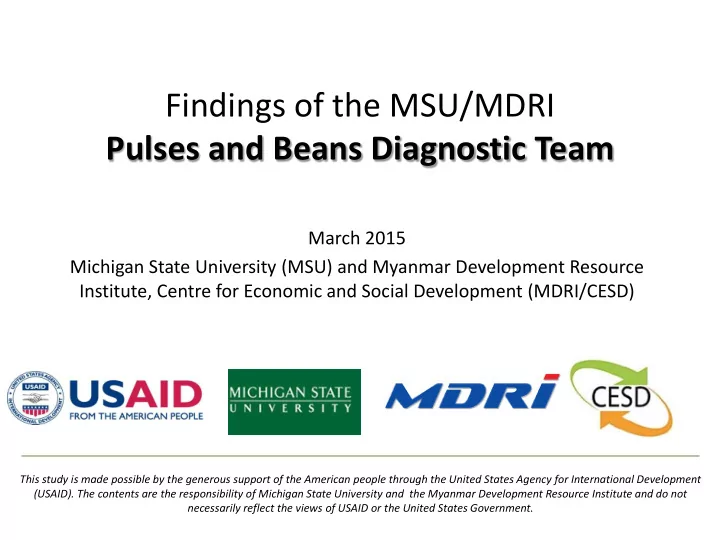

Findings of the MSU/MDRI Pulses and Beans Diagnostic Team March 2015 Michigan State University (MSU) and Myanmar Development Resource Institute, Centre for Economic and Social Development (MDRI/CESD) This study is made possible by the generous support of the American people through the United States Agency for International Development (USAID). The contents are the responsibility of Michigan State University and the Myanmar Development Resource Institute and do not necessarily reflect the views of USAID or the United States Government.
Outline of presentation 1. Introduction to the study: objectives and methods 2. Global pulses and beans market: Myanmar’s golden opportunity 3. Myanmar’s global competitors 4. Myanmar pulse and bean sector strengths and weaknesses 5. What will it take for Myanmar pulses and beans sector to succeed in the global market?
1. Introduction: Study objectives a) Understand current situation and future potential for pulse and bean sector to increase agricultural economic growth and farmer incomes b) What needs to happen to realize this potential? – public investments – supportive policies – private sector agribusinesses and farmer roles
Methods • Field visits to production zones • MOAI Research and extension • Myanmar traders and commodity exchanges • Processing factories • Singapore based traders • SGS
2. Myanmar’s golden opportunity • Strong growth in global demand – Population growth – 9 billion consumers by 2050 – Affordable source of protein – Health benefits for consumers – Environmental benefits • Potential growth in domestic demand – Potential to increase domestic consumption – By-products for feed industry (fish, dairy, poultry)
Myanmar’s golden opportunity (cont.) • High production potential in Myanmar – Pulses fit well with rice-based cropping systems in Delta and diversified production systems in Dry Zone – Current yields low compared to potential • High potential to increased value per ton exported – Diversification into high value markets – Value added products
3. Myanmar’s global competition • 2016: UN International Year of Pulses – Global Pulse Convention in Las Vegas April 2015 • Myanmar’s competitors are developing strategies to increase production and capture export market share: – Market intelligence – Investment in agricultural research – Joint strategies between farmers, processors and exporters and government – Branding and advertising promotion campaigns
3. Examples of global competition • Australia increased its production of green mungbean 500% in five years 2005-10 and developed completely new markets (Vietnam) • US Dry Bean Council sent a trade mission to Myanmar in February to assess whether its high value export markets are under threat • Key message: Myanmar MUST HAVE an industry strategy to compete globally
Historical performance of pulses in Myanmar: has growth stalled? 2,000 1,800 1,600 1,400 1,200 1,000 800 600 400 200 0 1980 1985 1990 1995 2000 2005 2010 Exports ('000 tons)
4. Strengths and weaknesses: a) Strengths in production • Good growing conditions for pulses – Diverse agro-ecologies • Large number of motivated farmers • Availability of improved varieties and extension – Domestic varieties not diffused – International germplasm not utilized
4. Strengths and weaknesses: b) Weaknesses in production Lack of access to improved technology: • Lack of access to irrigation • Lack of access to improved seeds • Disease build-up requires treat or buy clean seeds • Tight time windows between paddy harvest and pulses sowing • Lack of information on pest management • Lack of instructions in Myanmar language • Banned pesticides
Limited public budget for agriculture Agricultural research spending ($ per $100 Location in agric. output) Developed world 2.40 Sub-Saharan Africa 0.72 Developing world 0.53 Asia, 2008 0.41 Myanmar, 2003 0.06 Source: ASTI (2009).
4. Strengths and weaknesses: c) Strengths in marketing • Large number of traders and exchanges with good information • Proximity to large markets and/or high value markets • Advanced grading and sorting facilities • Presence of Singapore based companies with international market linkages
5. Strengths and weaknesses: d) Weaknesses in marketing • Heavy dependence on one or two low value export markets results in unstable demand and highly volatile prices
4. Strengths and weaknesses: d) Weaknesses in marketing (cont.) • Lack of value added processing capacity • Lack of quality discovery / preservation in value chain -> lack of quality price incentives for farmers and lack of traceability • Lack of bank finance for marketing – dependent on international traders for finance – Tension between Singapore and local traders
5. What will it take to achieve a golden era for Myanmar pulses? OR ?
Three Alternative Pathways Annual value of pulse exports 2. The Long Game: Farm productivity investments and high value market growth 1. The Short Game: Farm productivity Investments 0 . Baseline Trajectory: Business as Usual 2030 2010 2020
Long Game Discussion Group Question set 1: farm productivity • What kinds of innovations or investments are needed to help farmers increase productivity? • Who should be responsible for implementing these investments? • What partnerships between government, private sector and NGOs/civil society would be helpful?
Question set 2: accessing high value markets • What countries offer potential high value market opportunities for Myanmar? • How to increase share of exports to these high value markets? • How to increase share of exports in processed (value added form)? • What partnerships between government and private sector are needed to achieve this?
Question set 3: Myanmar traders and OATAM • Would the relationships between Myanmar traders and OATAM be more effective if Myanmar traders had access to credit from Myanmar banks for trading? • How could banks be encouraged to provide more credit to Myanmar traders? • What would be the effect of allowing international companies to trade in kyat IF they invest in value added processing plants?
Thank you !
Recommend
More recommend